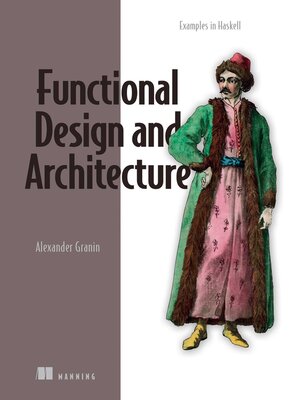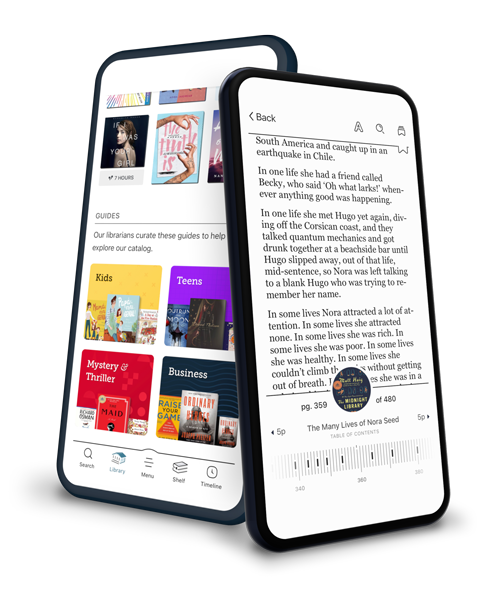
Sign up to save your library
With an OverDrive account, you can save your favorite libraries for at-a-glance information about availability. Find out more about OverDrive accounts.
Find this title in Libby, the library reading app by OverDrive.



Search for a digital library with this title
Title found at these libraries:
| Loading... |
Design patterns and architectures for building production quality applications using functional programming.
Functional Design and Architecture is a pioneering guide to software engineering using Haskell and other functional languages. In it, you'll discover Functional Declarative Design and other design principles perfect for working in Haskell, PureScript, F#, and Scala.
In Functional Design and Architecture you will learn:
Designing production applications in statically typed functional languages such as Haskell
Controlling code complexity with functional interfaces
Architectures, subsystems, and services for functional languages
Developing concurrent frameworks and multithreaded applications
Domain-driven design using free monads and other functional tools
Property-based, integrational, functional, unit, and automatic whitebox testing
Functional Design and Architecture lays out a comprehensive and complete approach to software design that utilizes the powerful and fascinating ideas of functional programming. Its examples are in Haskell, but its universal principles can be put into practice with any functional programming language. Inside, you'll find cutting-edge functional design principles and practices for every stage of application development, from architecting your application through to running simple and maintainable tests.
About the technology
Functional programming affects every aspect of software development, from how you write individual lines of code to the way you organize your applications and data. In fact, many standard OO patterns are unsuitable or unnecessary for FP applications. This book will reorient your thinking to align software design with a functional programming style. The examples are in Haskell, but the ideas are universal.
About the book
Functional Design and Architecture teaches you how to design software following the unique principles of functional programming. You'll explore FP-first paradigms like Functional Declarative Design by building interesting applications, including a fun spaceship control simulator and a full-fledged backend framework. This is an opinionated book and you may disagree on some points. But we guarantee it will make you think in a fresh way about how you design software.
What's inside
Control code complexity with functional interfaces
Architectures, subsystems, and services for functional languages
Domain-driven design using free monads
Property-based and automatic whitebox testing
Recalibrate OO designs for functional environments
About the reader
For experienced developers who know a functional language.
About the author
Alexander Granin is a senior software engineer and architect with more than 15 years of experience. He is an international speaker, researcher, and book author.
The technical editor on this book was Arnaud Bailly.
Table of Contents
Part 1
1 What is software design?
2 The basics of functional declarative design
Part 2
3 Drafting the MVP application
4 End-to-end design
Part 3
5 Embedded domain-specific languages
6 Domain modeling with free monads
Part 4
7 Stateful applications
8 Reactive applications
Part 5
9 Concurrent application framework
10 Foundational subsystems
11 Persistence: Key–value databases
12 Persistence: Relational databases
13 Error handling and dependency inversion
14 Business logic design
15 Testing
A...
Functional Design and Architecture is a pioneering guide to software engineering using Haskell and other functional languages. In it, you'll discover Functional Declarative Design and other design principles perfect for working in Haskell, PureScript, F#, and Scala.
In Functional Design and Architecture you will learn:
Functional Design and Architecture lays out a comprehensive and complete approach to software design that utilizes the powerful and fascinating ideas of functional programming. Its examples are in Haskell, but its universal principles can be put into practice with any functional programming language. Inside, you'll find cutting-edge functional design principles and practices for every stage of application development, from architecting your application through to running simple and maintainable tests.
About the technology
Functional programming affects every aspect of software development, from how you write individual lines of code to the way you organize your applications and data. In fact, many standard OO patterns are unsuitable or unnecessary for FP applications. This book will reorient your thinking to align software design with a functional programming style. The examples are in Haskell, but the ideas are universal.
About the book
Functional Design and Architecture teaches you how to design software following the unique principles of functional programming. You'll explore FP-first paradigms like Functional Declarative Design by building interesting applications, including a fun spaceship control simulator and a full-fledged backend framework. This is an opinionated book and you may disagree on some points. But we guarantee it will make you think in a fresh way about how you design software.
What's inside
About the reader
For experienced developers who know a functional language.
About the author
Alexander Granin is a senior software engineer and architect with more than 15 years of experience. He is an international speaker, researcher, and book author.
The technical editor on this book was Arnaud Bailly.
Table of Contents
Part 1
1 What is software design?
2 The basics of functional declarative design
Part 2
3 Drafting the MVP application
4 End-to-end design
Part 3
5 Embedded domain-specific languages
6 Domain modeling with free monads
Part 4
7 Stateful applications
8 Reactive applications
Part 5
9 Concurrent application framework
10 Foundational subsystems
11 Persistence: Key–value databases
12 Persistence: Relational databases
13 Error handling and dependency inversion
14 Business logic design
15 Testing
A...






